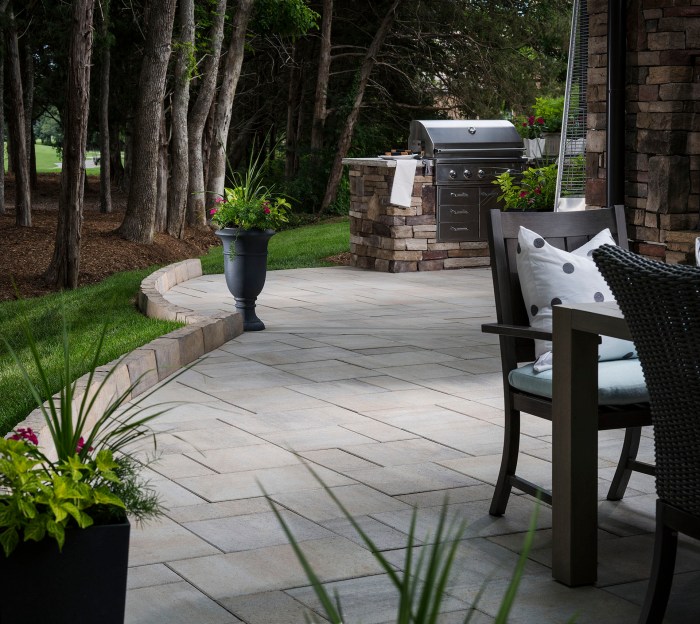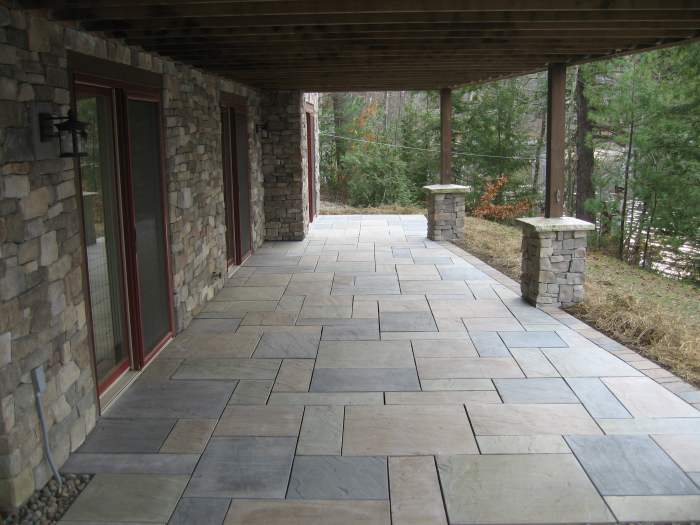Transform your outdoor space into a sophisticated haven with the perfect choice of pavers for your patio. From the classic elegance of natural stone to the modern allure of porcelain, a myriad of options await your selection. Embark on a journey to discover the diverse types of pavers, their unique characteristics, and how they can elevate the aesthetics and functionality of your patio.
As you navigate through this comprehensive guide, you’ll uncover the advantages and disadvantages of each paver type, empowering you to make an informed decision that aligns with your design vision and lifestyle. Whether you seek durability, visual appeal, or environmental sustainability, this guide will equip you with the knowledge to create a patio that seamlessly blends beauty and practicality.
Types of Pavers for Patio
When selecting pavers for your patio, it’s important to consider factors such as durability, aesthetics, and cost. Here’s an overview of the different types of pavers available:
Concrete Pavers
- Durable and affordable, with a wide range of styles and colors available.
- Can be smooth or textured, and come in various shapes and sizes.
- Susceptible to cracking and staining, and may require sealing for protection.
Clay Pavers
- Natural and durable, with a rich, earthy appearance.
- Resistant to fading and staining, and can last for decades.
- More expensive than concrete pavers, and can be slippery when wet.
Stone Pavers
- Durable and elegant, with a timeless aesthetic.
- Available in various types, such as granite, sandstone, and limestone.
- Can be expensive and require professional installation.
Porcelain Pavers
- Durable and stain-resistant, with a wide range of designs and finishes.
- Non-porous and easy to clean, making them ideal for outdoor use.
- Can be more expensive than other types of pavers.
Concrete Pavers
Concrete pavers are a popular choice for patios because they are durable, versatile, and relatively affordable. They are made from a mixture of cement, sand, and aggregate, and they can be formed into a variety of shapes and sizes. Concrete pavers are also available in a wide range of colors, so you can find the perfect match for your patio design.
Advantages of Concrete Pavers
* Durability: Concrete pavers are very durable and can withstand heavy foot traffic and extreme weather conditions. They are also resistant to stains and fading, so they will look great for years to come.
Versatility
Concrete pavers can be used to create a variety of different looks, from traditional to contemporary. They can be laid in a variety of patterns, and they can be used to create borders, walkways, and other features.
Affordability
Concrete pavers are a relatively affordable option compared to other types of paving materials, such as natural stone or brick.
Disadvantages of Concrete Pavers
* Weight: Concrete pavers are heavy, so they can be difficult to install. You may need to hire a professional to install your concrete pavers, which will add to the cost of your project.
Cracking
Concrete pavers can crack if they are not installed properly or if they are subjected to extreme weather conditions.
Choosing the Right Concrete Pavers
When choosing concrete pavers for your patio, there are a few things to keep in mind:* The style of your patio: The style of your patio will determine the type of concrete pavers that you choose. For example, if you have a traditional-style patio, you may want to choose pavers with a classic look.
If you have a contemporary-style patio, you may want to choose pavers with a more modern look.
The size of your patio
The size of your patio will also determine the type of concrete pavers that you choose. If you have a small patio, you may want to choose smaller pavers. If you have a large patio, you may want to choose larger pavers.
The color of your patio
The color of your patio will also determine the type of concrete pavers that you choose. If you have a light-colored patio, you may want to choose pavers in a light color. If you have a dark-colored patio, you may want to choose pavers in a dark color.
Natural Stone Pavers
Natural stone pavers offer an elegant and durable option for patios. They are available in a variety of colors, textures, and shapes, making them suitable for any design style. Natural stone pavers are also highly durable and can withstand heavy foot traffic and weather conditions.
Types of Natural Stone Pavers
The most common types of natural stone pavers used for patios include:
- Granite: Granite is a very hard and durable stone that is resistant to scratching and wear. It is available in a variety of colors, including black, gray, red, and brown.
- Limestone: Limestone is a softer stone than granite, but it is still very durable. It is available in a variety of colors, including white, cream, and beige.
- Sandstone: Sandstone is a soft and porous stone that is not as durable as granite or limestone. However, it is still a popular choice for patios because of its natural beauty. Sandstone is available in a variety of colors, including red, brown, and yellow.
Choosing the Right Natural Stone Pavers
When choosing natural stone pavers for your patio, it is important to consider the following factors:
- Climate: The climate in your area will affect the type of natural stone pavers that you choose. If you live in a cold climate, you will need to choose a stone that is resistant to freeze-thaw cycles.
- Traffic: The amount of traffic that your patio will receive will also affect the type of natural stone pavers that you choose. If you expect a lot of foot traffic, you will need to choose a stone that is durable and resistant to wear.
- Style: The style of your patio will also influence the type of natural stone pavers that you choose. If you want a traditional look, you may want to choose a stone like granite or limestone. If you want a more modern look, you may want to choose a stone like sandstone.
Brick Pavers
Brick pavers are a classic and versatile choice for patios, offering a wide range of colors, textures, and patterns. They are durable, easy to maintain, and can add a touch of elegance to any outdoor space.Brick pavers are made from clay, concrete, or recycled materials.
Clay pavers are the most traditional type and are known for their rich colors and durability. Concrete pavers are a more affordable option and come in a variety of colors and styles. Recycled brick pavers are made from crushed brick and are a sustainable choice.When
choosing brick pavers for your patio, it is important to consider the following factors:*
-*Color
Brick pavers come in a wide range of colors, from traditional reds and browns to more modern grays and blacks. Choose a color that complements the style of your home and outdoor décor.
-
-*Texture
Brick pavers can have a smooth, textured, or tumbled finish. Smooth pavers are easier to clean, while textured pavers can add visual interest. Tumbled pavers have a distressed look that can give your patio a more rustic feel.
-*Pattern
Brick pavers can be laid in a variety of patterns, including herringbone, basket weave, and running bond. Choose a pattern that suits the size and shape of your patio.
Porcelain Pavers
Porcelain pavers are a popular choice for patios because they are durable, easy to maintain, and come in a wide variety of styles, shapes, and colors.
They are also resistant to fading, scratching, and staining, making them a good choice for areas that receive a lot of foot traffic or are exposed to the elements.One of the main advantages of porcelain pavers is that they are very durable.
They are made from a type of ceramic that is fired at a high temperature, which makes them very strong and resistant to wear and tear. They are also non-porous, which means that they will not absorb water or stains.
This makes them a good choice for areas that are prone to spills or moisture.Porcelain pavers are also relatively easy to maintain. They can be cleaned with a simple soap and water solution, and they do not require any special sealants or coatings.
They are also resistant to fading, so they will not lose their color over time.However, there are also some disadvantages to using porcelain pavers. They can be more expensive than other types of pavers, and they can be difficult to install.
They are also not as slip-resistant as some other types of pavers, so they may not be the best choice for areas that are prone to wet or icy conditions.
Styles, Shapes, and Colors
Porcelain pavers come in a wide variety of styles, shapes, and colors. They can be found in both traditional and contemporary designs, and they can be used to create a variety of different looks.Some of the most popular styles of porcelain pavers include:
- Travertine
- Slate
- Marble
- Limestone
- Wood
Porcelain pavers can also be found in a variety of shapes, including:
- Square
- Rectangle
- Hexagon
- Octagon
- Random
Finally, porcelain pavers come in a wide range of colors, including:
- Beige
- Brown
- Gray
- Black
- White
Choosing the Right Porcelain Pavers
When choosing porcelain pavers for a patio, it is important to consider the following factors:
- The style of the patio
- The size of the patio
- The amount of foot traffic the patio will receive
- The climate in which the patio is located
Once you have considered these factors, you can begin to narrow down your choices. It is also a good idea to visit a local tile store to see the different styles and colors of porcelain pavers in person.
Permeable Pavers
Permeable pavers, also known as porous pavers, are a type of paving material designed to allow water to pass through them, reducing runoff and improving drainage. These pavers are made from a variety of materials, including concrete, natural stone, and recycled materials.Permeable
pavers offer several advantages for patio applications. They help reduce stormwater runoff, which can lead to flooding and erosion. They also allow water to infiltrate the ground, which can help recharge groundwater supplies. Additionally, permeable pavers can help reduce the urban heat island effect by absorbing and releasing heat.
Environmental Benefits of Permeable Pavers
* Reduced stormwater runoff: Permeable pavers allow water to pass through them, reducing runoff and the risk of flooding and erosion.
Improved water quality
The water that passes through permeable pavers is filtered by the soil beneath, removing pollutants and improving water quality.
Reduced urban heat island effect
Permeable pavers absorb and release heat, helping to reduce the urban heat island effect.
Choosing the Right Permeable Pavers
When choosing permeable pavers for a patio, there are several factors to consider, including:* Material: Permeable pavers are available in a variety of materials, including concrete, natural stone, and recycled materials. Each material has its own advantages and disadvantages, so it is important to choose the right material for the specific application.
Size and shape
Permeable pavers are available in a variety of sizes and shapes, so it is important to choose the right size and shape for the patio design.
Color
Permeable pavers are available in a variety of colors, so it is important to choose the right color for the patio design.
Cost
Permeable pavers can be more expensive than traditional paving materials, so it is important to factor in the cost when choosing permeable pavers.
Patio Paver Patterns
Patio paver patterns can greatly influence the overall look and feel of your outdoor space. Here are some popular patterns to consider:
Herringbone
The herringbone pattern is a classic choice that creates a sophisticated and elegant look. It involves laying the pavers in a zigzag pattern, alternating the direction of each row. This pattern adds visual interest and movement to your patio.
Running Bond
The running bond pattern is a simple and versatile option that creates a clean and modern look. It involves laying the pavers in straight rows, with the joints between the pavers aligned. This pattern is easy to install and provides a timeless look that complements various patio designs.
Basket Weave
The basket weave pattern is a more intricate option that creates a unique and eye-catching look. It involves laying the pavers in a series of interlocking squares, with the pavers alternating between vertical and horizontal orientations. This pattern adds texture and depth to your patio.
When choosing a patio paver pattern, consider the overall style of your patio, the size and shape of the area, and the functionality you desire. A herringbone pattern can create a more formal look, while a running bond pattern is more casual and modern.
A basket weave pattern can add visual interest and depth to a larger patio.
Patio Paver Installation
Installing patio pavers is a great way to add beauty and functionality to your outdoor space. With proper preparation and installation, your patio pavers can last for many years to come.Here’s a step-by-step guide on how to install patio pavers:
Preparing the Base
Before you start laying pavers, you need to prepare the base. This involves removing any existing vegetation, leveling the ground, and compacting the soil. You may also need to install a drainage system to prevent water from pooling under the pavers.
Laying the Pavers
Once the base is prepared, you can start laying the pavers. Start by setting a straight edge along one side of the patio and laying the first row of pavers. Use a level to make sure the pavers are level and even.Continue
laying pavers, working your way across the patio. Use a rubber mallet to tap the pavers into place and a level to check the level as you go.
Sealing the Surface
Once the pavers are laid, you need to seal the surface to protect them from the elements. There are a variety of sealers available, so be sure to choose one that is appropriate for the type of pavers you have.Apply
the sealer according to the manufacturer’s instructions. Be sure to allow the sealer to dry completely before using the patio.
Patio Paver Maintenance
Maintaining your patio pavers is crucial for preserving their aesthetic appeal and extending their lifespan. Regular cleaning, sealing, and repairs are essential for keeping your patio looking its best.
Cleaning
Regular cleaning removes dirt, debris, and stains from your pavers. Use a pressure washer with a wide nozzle and low pressure setting to avoid damaging the pavers. For stubborn stains, apply a mild detergent solution and scrub with a soft-bristled brush.
Rinse thoroughly with water afterward.
Sealing
Sealing your pavers protects them from water damage, stains, and UV rays. Apply a high-quality paver sealant according to the manufacturer’s instructions. Reapply sealant every few years to maintain protection.
Repairing
Over time, pavers may become cracked or broken. For minor cracks, fill them with a flexible sealant. For larger cracks or broken pavers, remove the damaged paver and replace it with a new one. Use a rubber mallet to level the new paver with the surrounding ones.
Closing Summary
The choice of pavers for your patio is a testament to your personal style and the desired ambiance of your outdoor oasis. Each type of paver offers a distinct character, durability, and aesthetic appeal, allowing you to customize your patio to reflect your unique taste.
Remember, the perfect pavers are those that harmoniously blend with your surroundings, creating a cohesive and inviting outdoor space that you’ll cherish for years to come.



